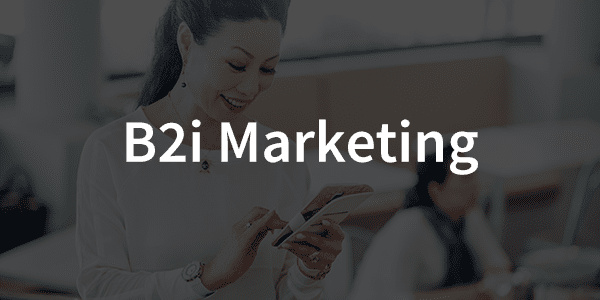What is B2i marketing and how can it help you make your marketing smarter?
You’ve heard of B2B and B2C - But what about B2i? B2B marketers and strategists are quickly adopting this emerging trend that puts their businesses in direct contact with their clients’ end-consumers: from business to individual.
As the world becomes more interconnected, businesses are beginning to understand that they must think beyond the needs of their immediate clients and consider their clients’ clients as well. Sure, they still might sell directly to the CEOs, CIOs, and other C-suite executives. But their solutions must address their clients’ core needs, which always go back to the individual consumer.

Most people assume that the “I” in B2i is for “internet.” But B2i isn’t about online marketing. B2i demands a holistic view of a client’s business, especially as companies create new business models to meet the needs of various segments within their audience.
We see evidence of this in the ways companies are changing. Tesla isn’t a car manufacturer; it’s a technology company that also happens to produce vehicles, and its offerings will evolve with its markets. Similarly, banks aren’t just banks anymore; they now offer more than just retail banking services via mobile platforms and online products. And then there’s a European telecommunications company that functions as a telecom company in some countries and as a bank in others.
The lines between industries blur more and more all the time, and companies ahead of the curve are adopting agile strategies to keep up with their customers’ demands.
Individuals, not Internet
B2i strategies require fundamental changes in an organization’s mindset. IBM is leading the B2i charge by investing in consumer-friendly products and cognitive technology that will enhance people’s daily experiences. The individualized approach to marketing demands more than tailored email campaigns and content. It calls for a comprehensive overhaul in how marketers approach their work.
IBM isn’t the only corporation reevaluating its ecosystem. Capital One launched Capital One Labs, which runs as a startup accelerator within the parent company, to improve its consumer offerings. The Labs team works on long-term innovations that will be launched on two- to three-year timelines to accommodate the future needs of its market.
A future-focused mentality is critical to B2i. Technology is revolutionizing every industry, and changes are coming fast. Companies that adapt a B2i mentality are best equipped to anticipate and meet those challenges.
B2i is a nuanced area that’s becoming more complex as the concept gains traction. But the key components that marketers need to keep in mind, which will remain regardless of how B2i changes, are empathy and a future-focused outlook.
Here’s how to create a B2i ethos in your marketing organization:
1. Cultivate empathy.
Everyone on the marketing and sales teams must be able to think like your clients and the customers they serve. What are the clients’ challenges when connecting with their audiences? Why are their leads hesitant to convert? Is there a lack of trust between clients and customers? Is pricing the issue? Thinking like both parties enables you to connect the dots. Then you can offer solutions to solve your market’s deepest problems.
IBM displays this commitment to empathy with its “Diamond Teams.” Each of these teams is comprised of individuals with specific, varied areas of expertise — marketing experts, product experts, and industry profession experts — to focus on cultivating understanding and building trust with the individuals the company serves.
2. Emphasize relevance.
You’re not simply getting more eyes on clients’ smartphone ads anymore. B2i marketing takes you to the heart of the message and calls for resonant, concrete strategies. If you’re working with a healthcare provider, you might need to articulate its response to the question “How do I provide better care to cancer patients?” Your job is to package the answer across every medium that might reach the client’s audience. The beauty of B2i is that it combines valuable messaging with relevant, powerful technologies.
3. Anticipate all discovery paths.
The proliferation of smartphones and digital media forced marketing teams to develop more sophisticated strategies in recent years. Now, B2i is pushing them further. Audiences vet brands before they buy, and they’re not afraid to share their opinions publicly on social media platforms. Again, you must think like consumers to ensure that your clients are fostering positive relationships at every gateway. Strategies might include free trials, generous return policies, and other enticements that build trust.
4. Prepare for the future.
Automation is already changing the way businesses operate and how consumers manage their daily lives. That trend will only increase, especially as machine learning and artificial intelligence become more prominent. As that happens, companies will reclaim considerable financial and personnel resources that can be directed into new products and marketing strategies. Track these technologies carefully, and educate yourself and your clients on what they mean. Then develop B2i campaigns using the new tools and resources at your disposal.
B2i will affect every aspect of marketing, from email campaigns to social strategies to influencer partnerships. And that’s something to celebrate. The nature of B2i is to connect with human beings. When you’re simply trying to attract more clicks to a client’s website, you can forget about the individuals on the other side. But B2i brings all parties more fully into the picture and creates people-centric perspectives.

Thanks to
Naveen Rajdev for sharing their advice and opinions in this post.Rajdev is the chief marketing officer for
Wipro, a global information technology, consulting, and outsourcing company. Naveen manages the global marketing team, which implements all brand initiatives. He believes that powerful technology brands are built on human principles and has been moving Wipro toward becoming a more digital and people-centric brand, leading the foundation of what he calls the “B2i” (i.e., business to individuals) future. The views expressed in this article are his own




 Thanks to
Thanks to 



